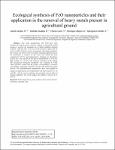Ecological synthesis of FeO nanoparticles and their application in the removal of heavy metals present in agricultural ground [Síntesis ecológica de nanopartículas de FeO y su aplicación en la remoción de metales pesados presentes en suelo agrícola]

View/
Descargar
(application/pdf: 623.1Kb)
(application/pdf: 623.1Kb)
Date
2021-09-08Author(s)
Asmat Campos, David Angel
Andrade Zavaleta, Karin Lizbeth
Chacon Laiza, Yessica Laurita
Henriquez Alegría, Ana Cecilia Francisca
Iparraguirre Paredes, Fiorella Arely
Metadata
Show full item recordAbstract
Se ha sintetizado nanopartículas de óxido de hierro
(NP FeO) usando el método de química verde, un método sostenible
debido a que implica el uso mínimo de reactivos químicos altamente
contaminantes, reduciéndose solo al uso del agente precursor y el
extracto en solvente alcohólico 96% de eucalipto (Eucaliptus
globulus), este solvente mostró tener excelentes propiedades
reductoras debido a los metabolitos que contiene. En ese sentido, se
ha evaluado por espectrofotometría UV-Vis el coloide, obteniéndose
un pico de absorbancia a 391.2 nm, típico para este tipo de
nanomaterial, así mismo se ha observado una alta estabilidad como
resultado de la evaluación temporal del coloide. El mecanismo de
formación de nanopartículas se evaluó por FTIR lo que ha permitido
verificar parcialmente que los grupos correspondientes a los
compuestos aromáticos y alifáticos estarían implicados en el proceso
de formación de NP FeO. Las nanopartículas mencionadas han sido
aplicadas a muestras de suelo agrícola contaminadas con metales
pesados (Cr, Cd y Pb), con el objetivo de evaluar el potencial efecto
de remoción de contaminantes metálicos, los resultados sugieren la
remoción definitiva del Cr y Cd.
Mostrar más
Iron oxide nanoparticles (NP FeO) have been
synthesized using the green chemistry method, a sustainable method
because it involves the minimum use of highly polluting chemical
reagents, reducing only to the use of the precursor agent and the
extract in 96% alcoholic solvent of eucalyptus (Eucalyptus globulus),
this solvent was shown to have excellent reducing properties due to
the metabolites it contains. In this sense, the colloid has been
evaluated by UV-Vis spectrophotometry, obtaining an absorbance
peak at 391.2 nm, typical for this type of nanomaterial, as well as a
high stability as a result of the temporal evaluation of the colloid.
The nanoparticle formation mechanism was evaluated by FTIR,
which partially verified that the groups corresponding to aromatic
and aliphatic compounds would be involved in the NP FeO formation
process. The aforementioned nanoparticles have been applied to
samples of agricultural soil contaminated with heavy metals (Cr, Cd
and Pb), with the aim of evaluating the potential removal effect of
metallic pollutants, the results suggest the definitive removal of Cr
and Cd.
Mostrar más
Bibliographic citation
Asmat, D. A., Andrade, K. L., Chacon, Y. L., Henriquez, A. C., & Iparraguirre, F. A. (2021). Ecological synthesis of FeO nanoparticles and their application in the removal of heavy metals present in agricultural ground [Síntesis ecológica de nanopartículas de FeO y su aplicación en la remoción de metales pesados presentes en suelo agrícola]. Proceedings of the LACCEI International Multi-conference for Engineering, Education and Technology, 2021-July(19). http://dx.doi.org/10.18687/LACCEI2021.1.1.19
Collections
The following license files are associated with this item:


